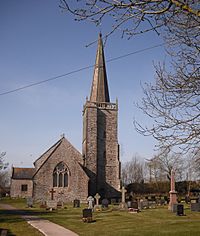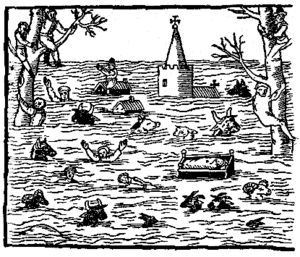St Mary's Church, Nash facts for kids
Quick facts for kids Church of St Mary, Nash |
|
|---|---|
| Church of St Mary the Virgin, Nash | |

The church from the east
|
|
| Location | Nash |
| Country | Wales |
| Denomination | Church in Wales |
| History | |
| Status | Active |
| Dedication | St Mary |
| Architecture | |
| Functional status | Parish church |
| Heritage designation | Grade I |
| Designated | 3 January 1963 |
| Specifications | |
| Number of spires | 1 |
| Administration | |
| Parish | Rectorial Benefice of Magor |
| Diocese | Monmouth |
The Church of St Mary the Virgin, Nash is a special church in the village of Nash. It's about 2 miles south of Newport, Wales. A historian named Fred Hando called it "the cathedral of the moors" because it's so big and important. This church is very old, built in the Middle Ages. It was updated in the 1700s and 1800s. An expert named Newman said its tall, pointy tower from the 1400s is special and unlike any other in South East Wales. Since 1963, it has been a Grade I listed building. This means it's a very important historic building.
What the Church Looks Like
The church has three main parts. It has a tall, three-story tower from the 1400s with an eight-sided spire. This tower does not have an entrance to the main part of the church. The middle part of the church, called the nave, was built in the 1700s. The front part, called the chancel, was built in the 1800s.
Inside, the church looks like it did in the Georgian times. It has a special balcony, enclosed seating areas called box pews, and a tall, three-level pulpit where the priest speaks. The church was made a Grade I listed building in 1963. This was mainly because of its old tower and beautiful spire.
A Look at the Church's History
The church belonged to Goldcliff Priory in 1349. At that time, Robert Arney became the priest. Later, the Arney family, during the time of King Charles II, gave a cottage and 6 acres of land. This land, called "The Poor's Six Acres," was meant to help the poor people of the village. The church was mostly rebuilt in the 1500s.
Only a few parts of the original Norman church remain. These include the North Wall of the chancel and a small opening called a squint or hagioscope. This squint was unusual. It allowed people with certain illnesses to see or join the church service. This way, they could participate without making others sick. The church's tower is also in an unusual spot, on the north side of the chancel. People think the church was once much bigger, possibly with another section on the north side.
In the early 1900s, the bellringer's room was used as a temporary place for bodies. Five sailors had drowned in a big storm near the East Usk Lighthouse. Four of them were found tied to the ship's mast. During World War II, many people came to the church, with up to 400 attending services.
The inside of the church was repaired and made new in 2004 and 2005. Today, Sunday services are held every week. The church is also open daily during July and August for visitors.
Monmouthshire historian Fred Hando famously called the church "the cathedral of the moors." Newman, an expert on buildings, said the church's tower from the 1400s is "unique in South East Wales."
The Great Flood of 1607
On January 30, 1607, a huge flood hit the Bristol Channel. Many people drowned, and a lot of farms and animals were lost. Recent studies suggest this flood was likely caused by a very strong storm surge. There is a special plaque remembering this event in St Mary's Church in nearby Goldcliff. An old picture from the time of the flood shows a church that many believe is St Mary's, Nash.


